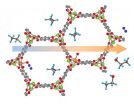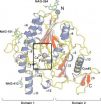(Press-News.org) New Rochelle, NY, May 22, 2014—To make up for insufficient amounts of SMN protein, the cause of the inherited neuromuscular disease spinal muscular atrophy (SMA), researchers have successfully delivered a replacement SMN1 gene directly to the spinal cords of animal models of SMA. A new study demonstrating that enough copies of the SMN1 gene can be delivered to the spinal cord motor neurons to extend the survival of the treated animals is published in Human Gene Therapy, a peer-reviewed journal from Mary Ann Liebert, Inc., publishers. The article is available free on the Human Gene Therapy website.
Marco Passini and coauthors from Genzyme (Framingham, MA), University of California San Francisco, Emory University School of Medicine (Atlanta, GA), and Georgetown University Medical Center (Washington, DC) used an adeno-associated viral vector as the delivery vehicle to transport copies of the SMN1 gene into motor neurons in the spinal cord via intrathecal delivery. They report on the effectiveness of restoring the levels of functional SMN protein in normal pig and non-human primate SMA models that would predict efficacy based on gene transfer with the same vector in an authentic mouse model of SMA in the article "Translational Fidelity of Intrathecal Delivery of Self-Complementary AAV9–Survival Motor Neuron 1 for Spinal Muscular Atrophy."
"This is a very promising and thorough set of preclinical studies that supports rapid translation to the clinic," says James M. Wilson, MD, PhD, Editor-in-Chief of Human Gene Therapy, and Director of the Gene Therapy Program, Department of Pathology and Laboratory Medicine, University of Pennsylvania Perelman School of Medicine, Philadelphia.
INFORMATION:
About the Journal
Human Gene Therapy, the official journal of the European Society of Gene and Cell Therapy, British Society for Gene and Cell Therapy, French Society of Cell and Gene Therapy, German Society of Gene Therapy, and five other gene therapy societies, is an authoritative peer-reviewed journal published monthly in print and online. Human Gene Therapy presents reports on the transfer and expression of genes in mammals, including humans. Related topics include improvements in vector development, delivery systems, and animal models, particularly in the areas of cancer, heart disease, viral disease, genetic disease, and neurological disease, as well as ethical, legal, and regulatory issues related to the gene transfer in humans. Its sister journals, Human Gene Therapy Methods, published bimonthly, focuses on the application of gene therapy to product testing and development, and Human Gene Therapy Clinical Development, published quarterly, features data relevant to the regulatory review and commercial development of cell and gene therapy products. Tables of content for all three publications and a free sample issue may be viewed on the Human Gene Therapy website.
About the Publisher
Mary Ann Liebert, Inc., publishers is a privately held, fully integrated media company known for establishing authoritative peer-reviewed journals in many areas of science and biomedical research, including Nucleic Acid Therapeutics, Tissue Engineering, Stem Cells and Development, and Cellular Reprogramming. Its biotechnology trade magazine, Genetic Engineering & Biotechnology News (GEN), was the first in its field and is today the industry's most widely read publication worldwide. A complete list of the firm's 80 journals, books, and newsmagazines is available on the Mary Ann Liebert, Inc., publishers website.
INFORMATION: END
Gene therapy extends survival in an animal model of spinal muscular atrophy
2014-05-22
ELSE PRESS RELEASES FROM THIS DATE:
JILA study finds crowding has big effects on biomolecules
2014-05-22
Crowding has notoriously negative effects at large size scales, blamed for everything from human disease and depression to community resource shortages. But relatively little is known about the influence of crowding at the cellular level. A new JILA study shows that a crowded environment has dramatic effects on individual biomolecules.
In the first data on the underlying dynamics (or kinetics)of crowded single biomolecules , reported in Proceedings of the National Academy of Sciences,* JILA researchers found that crowding leads to a 35-fold increase in the folding rate ...
From separation to transformation: Metal-organic framework shows new talent
2014-05-22
This gift from science just keeps on giving. Measurements taken at the National Institute of Standards and Technology (NIST) show why a material already known to be good at separating components of natural gas also can do something trickier: help convert one chemical to another, a process called catalysis. The discovery is a rare example of a laboratory-made material easily performing a task that biology usually requires a complex series of steps to accomplish.
The material is a metal-organic framework (MOF), one of a class of substances whose porosity, high surface area ...
Don't blink! NIST studies why quantum dots suffer from 'fluorescence intermittency'
2014-05-22
Researchers at the National Institute of Standards and Technology (NIST), working in collaboration with the Naval Research Laboratory, have found that a particular species of quantum dots that weren't commonly thought to blink, do.
So what? Well, although the blinks are short—on the order of nanoseconds to milliseconds—even brief fluctuations can result in efficiency losses that could cause trouble for using quantum dots to generate photons that move information around inside a quantum computer or between nodes of a future high-security internet based on quantum telecommunications.
Beyond ...
Putting a number on opinion dynamics in a population
2014-05-22
Philadelphia, PA—Opinion formation in a large population is influenced by both endogenous factors, such as interaction with one's peers—in-person and via social media—as well as exogenous factors, such as the media, of which mainstream media is one of the most influential factors. For example, according to a study conducted by the National Bureau of Economic Research in 2006, after the introduction and expansion of Fox News in the United States between 1996 and 2000, an estimated 3-28% of the audience was persuaded to vote Republican.
In a recent paper published in ...
NIST chip produces and detects specialized gas for biomedical analysis
2014-05-22
A chip-scale device that both produces and detects a specialized gas used in biomedical analysis and medical imaging has been built and demonstrated at the National Institute of Standards and Technology (NIST). Described in Nature Communications,* the new microfluidic chip produces polarized (or magnetized) xenon gas and then detects even the faintest magnetic signals from the gas.
Polarized xenon—with the atoms' nuclear "spins" aligned like bar magnets in the same direction—can be dissolved in liquids and used to detect the presence of certain molecules. A chemical interaction ...
NCNR neutrons highlight possible battery candidate
2014-05-22
Analysis of a manganese-based crystal by scientists at the National Institute of Standards and Technology (NIST) and the Massachusetts Institute of Technology (MIT) has produced the first clear picture of its molecular structure. The findings could help explain the magnetic and electronic behavior of the whole family of crystals, many of which have potential for use in batteries.
The family of crystals it belongs to has no formal name, but it has three branches, each of which is built around manganese, cobalt or iron—transition metals that can have different magnetic ...
Bending helps to control nanomaterials
2014-05-22
A new remedy has been found to tackle the difficulty of controlling layered nanomaterials. Control can be improved by simply bending the material.
The mechanism was observed by Academy Research Fellow Pekka Koskinen from the Nanoscience Center of the University of Jyväskylä together with his colleagues from the University of Massachusetts Amherst in the US. Bending decreases interaction between layers, making the material merely a stack of independent atomic layers.
The group investigated the van der Waals nanomaterials which consist of stacked and loosely bound two-dimensional ...
Safety in numbers: Moderate drinking in a group reduces attraction to risk
2014-05-22
New research led by the University of Kent shows that individuals who have consumed moderate amounts of alcohol in social situations are likely to view risky situations with greater caution when considering them as part of a group.
The research, by psychologists from the University of Kent and the University of East Anglia, produced the first evidence found outside of laboratory conditions that being in a group can reduce some effects of alcohol consumption. The findings could lead to the design of new interventions designed to promote safer recreational drinking.
Researchers ...
Scientists provide insight into the pathology of Sanfilippo A syndrome
2014-05-22
Sanfilippo A syndrome or Mucopolysaccharidosis IIIA (MPS-IIIA) is a rare genetic lysosomal storage disease inherited from the parents of the patient. Lysosomes are the body's vehicle for breaking down many of its by-products such as proteins, nucleic acids, carbohydrates, lipids and cellular debris. The spherical vesicles are known to contain 50 different enzymes which are all active around an acidic environment of about pH 5.
Whilst each lysosomal disorder results from different gene mutations that translate into a deficiency in enzyme activity, they all share a common ...
Marriage of convenience with a fungus
2014-05-22
This news release is available in German. Thanks to a fungus, the medicinal plant ribwort plantain gains a higher concentration of the defensive compound catalpol. Biologists at Bielefeld University report this discovery in a study to be published this Thursday (22.5.2014) in the scientific journal 'Nature Communications'. The increase in catalpol gives the plant better protection against pests. In the study, the research team worked with arbuscular mycorrhizal fungi. These are known to colonize the roots of land plants. The plants benefit from this, because the fungus ...






